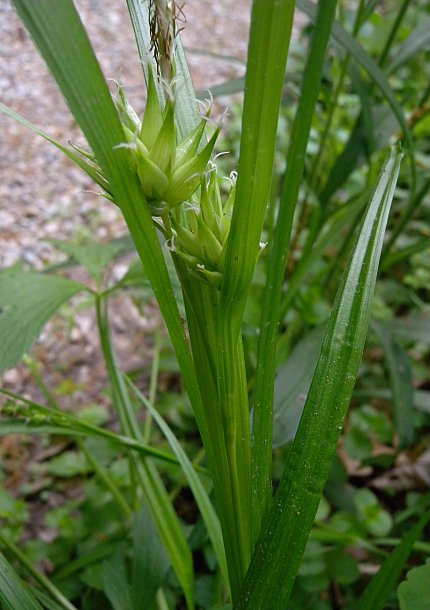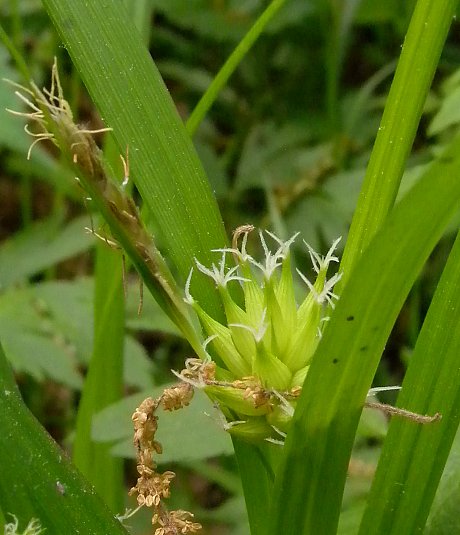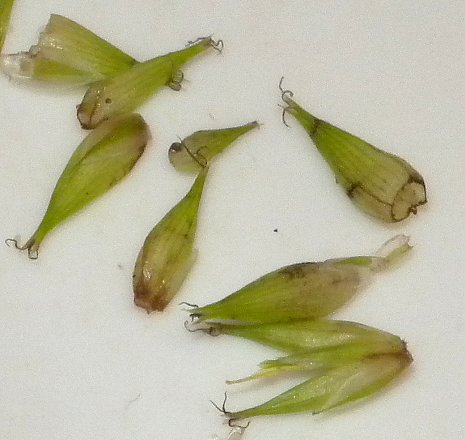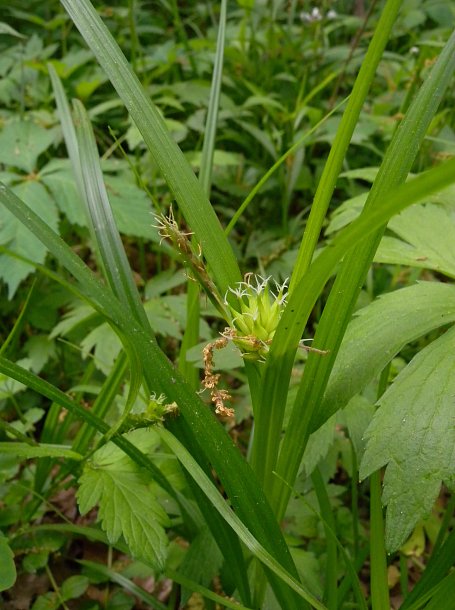Bladder Sedge
Carex intumescens
Sedge family (Cyperaceae)
Carex intumescens
Sedge family (Cyperaceae)
Description:
This sedge develops into a loose tuft of leafy culms that are 1–2¼'
tall
(rarely taller). There are about 5-6 leaves per fertile culm; the upper
leaf blades are generally larger in size than the lower leaf blades.
The culms are 3-angled, hairless, unbranched, and light green, becoming
purplish near the base. The leaf blades are up to 12" long and 8 mm.
(1/3") across; they are ascending, arching, and rather floppy.
Individual leaf blades are light green, hairless, and longitudinally
channeled. The hairless leaf sheaths are light green on two sides and
membranous on one side; the mouth of the membranous sheath is shallowly
U-shaped. Sometimes the sheaths are loose. The inflorescence consists
of 1–3 pistillate spikelets, a single terminal staminate spikelet, and
long floppy leafy bracts. The pistillate spikelets are about 2 cm. long
and
1.5 cm. across, consisting of 10–20 perigynia with pistillate florets
and scales. The perigynia are mostly ascending and they are
arranged together in a dense spiky cluster.

The peduncles (basal stalks) of the pistillate spikelets are up to 3.5 cm. long, erect to ascending, stiff, and relatively straight. Sometimes the pistillate spikelets are nearly sessile. The perigynia are 8-16 mm. long and lanceoloid in shape; they have rounded bottoms and taper into long slender beaks. The perigynia are light green above and whitish below (while immature), hairless, and longitudinally veined. The pistillate scales are about one-half to two-thirds of the length of the perigynia; they are ovate in shape with green-veined centers and broad membranous margins. The staminate spikelet is about 2.5 cm. long, whitish green to light brown, and very narrow; it typically has a stiff straight peduncle that is about 2 cm. long. The pistillate florets have 3 slender white styles, while the staminate florets have whitish anthers that soon turn brown; cross-pollination of the florets is by wind. The leafy bracts of the inflorescence are similar to leaf blades below and they over-top the inflorescence. The achenes are 3.5–5 mm. long and a little less across; they have an elongated and slightly flattened hexaploid shape with rounded angles and edges. The inflated perigynia have the capacity to float on water, spreading their achenes to new locations. The root system is fibrous and short-rhizomatous.

Cultivation: The preference is full sun to light shade, wet to mesic conditions, cool to moderate temperatures, and soil containing organic matter. Occasional flooding is readily tolerated.
Range & Habitat: The native Bladder Sedge (Carex intumescens) has been found in only a few counties in Illinois, where it is rare and state-listed as endangered (see Distribution Map). This sedge is widely distributed in the eastern half of the United States and adjacent areas of Canada; it is especially common in NE USA and the upper Great Lakes region. Habitats include floodplain woodlands, areas along woodland paths, soggy thickets, sedge meadows, marshes, and ditches. In Illinois, this sedge is most likely to be seen in higher quality natural areas.

Faunal Associations: Various invertebrate and vertebrate animals that live in woodlands and wetlands feed on the foliage and seeds of sedges (Carex spp.). Among insects, this includes aquatic leaf beetles (Plateumaris spp.), billbugs (Sphenophorus spp.), larvae of leaf-miner flies (Cerodontha spp.), seed bugs (Cymus angustatus, Oedancala dorsalis), aphids (Allaphis spp., Carolinaia spp., Iziphya spp., Subsaltusaphis spp.), larvae of grass-miner moths (Elachista spp.), larvae of skippers (Euphyes spp., Poanes spp.), larvae of butterflies (Satyrodes spp.), and sedge grasshoppers (Stethophyma spp.); see Clark et al. (2004), Vaurie (1983), Majka et al. (2007), Spencer & Steyskal (1986), Hoffman (1996), Marshall (2006), Blackman & Eastop (2013), Braun (1948), Bouseman et al. (2006), Bouseman & Sternburg (2001), and Capinera et al. (2004). The seeds of sedges are eaten by several species of birds, including ducks (Anas spp., Aythya spp.), sparrows (Melospiza spp.), various rails, Ruffed Grouse, Wild Turkey, and American Woodcock. Mammals that occasionally feed on the foliage of sedges include the American Moose, White-tailed Deer, and American Black Bear, however it is not a preferred food source (Martin et al., 1951/1961).

Photographic Location: Along a woodland path in Allerton Park, Piatt County, Illinois.
Comments: Bladder Sedge (Carex intumescens) is another sedge with inflated perigynia that is found around wetlands and sometimes woodlands. It resembles the more common Gray's Sedge (Carex grayi), but it tends to be found in somewhat sunnier habitats. Whereas the pistillate spikelets of Bladder Sedge are globoid-ovoid in outline (usually a little more long than across), the pistillate spikelets of Gray's Sedge are globoid in outline. While the perigynia of Bladder Sedge are mostly ascending in the pistillate spikelets (never descending), the perigynia of Gray's Sedge are ascending, spreading, and descending in the pistillate spikelets. In addition, the perigynia of Gray's Sedge are often finely short-hairy, while those of Bladder Sedge are never hairy. Other common names of Carex intumescens include Greater Bladder Sedge, Swollen Sedge, and Shining Bur Sedge.

The peduncles (basal stalks) of the pistillate spikelets are up to 3.5 cm. long, erect to ascending, stiff, and relatively straight. Sometimes the pistillate spikelets are nearly sessile. The perigynia are 8-16 mm. long and lanceoloid in shape; they have rounded bottoms and taper into long slender beaks. The perigynia are light green above and whitish below (while immature), hairless, and longitudinally veined. The pistillate scales are about one-half to two-thirds of the length of the perigynia; they are ovate in shape with green-veined centers and broad membranous margins. The staminate spikelet is about 2.5 cm. long, whitish green to light brown, and very narrow; it typically has a stiff straight peduncle that is about 2 cm. long. The pistillate florets have 3 slender white styles, while the staminate florets have whitish anthers that soon turn brown; cross-pollination of the florets is by wind. The leafy bracts of the inflorescence are similar to leaf blades below and they over-top the inflorescence. The achenes are 3.5–5 mm. long and a little less across; they have an elongated and slightly flattened hexaploid shape with rounded angles and edges. The inflated perigynia have the capacity to float on water, spreading their achenes to new locations. The root system is fibrous and short-rhizomatous.

Cultivation: The preference is full sun to light shade, wet to mesic conditions, cool to moderate temperatures, and soil containing organic matter. Occasional flooding is readily tolerated.
Range & Habitat: The native Bladder Sedge (Carex intumescens) has been found in only a few counties in Illinois, where it is rare and state-listed as endangered (see Distribution Map). This sedge is widely distributed in the eastern half of the United States and adjacent areas of Canada; it is especially common in NE USA and the upper Great Lakes region. Habitats include floodplain woodlands, areas along woodland paths, soggy thickets, sedge meadows, marshes, and ditches. In Illinois, this sedge is most likely to be seen in higher quality natural areas.

Faunal Associations: Various invertebrate and vertebrate animals that live in woodlands and wetlands feed on the foliage and seeds of sedges (Carex spp.). Among insects, this includes aquatic leaf beetles (Plateumaris spp.), billbugs (Sphenophorus spp.), larvae of leaf-miner flies (Cerodontha spp.), seed bugs (Cymus angustatus, Oedancala dorsalis), aphids (Allaphis spp., Carolinaia spp., Iziphya spp., Subsaltusaphis spp.), larvae of grass-miner moths (Elachista spp.), larvae of skippers (Euphyes spp., Poanes spp.), larvae of butterflies (Satyrodes spp.), and sedge grasshoppers (Stethophyma spp.); see Clark et al. (2004), Vaurie (1983), Majka et al. (2007), Spencer & Steyskal (1986), Hoffman (1996), Marshall (2006), Blackman & Eastop (2013), Braun (1948), Bouseman et al. (2006), Bouseman & Sternburg (2001), and Capinera et al. (2004). The seeds of sedges are eaten by several species of birds, including ducks (Anas spp., Aythya spp.), sparrows (Melospiza spp.), various rails, Ruffed Grouse, Wild Turkey, and American Woodcock. Mammals that occasionally feed on the foliage of sedges include the American Moose, White-tailed Deer, and American Black Bear, however it is not a preferred food source (Martin et al., 1951/1961).

Photographic Location: Along a woodland path in Allerton Park, Piatt County, Illinois.
Comments: Bladder Sedge (Carex intumescens) is another sedge with inflated perigynia that is found around wetlands and sometimes woodlands. It resembles the more common Gray's Sedge (Carex grayi), but it tends to be found in somewhat sunnier habitats. Whereas the pistillate spikelets of Bladder Sedge are globoid-ovoid in outline (usually a little more long than across), the pistillate spikelets of Gray's Sedge are globoid in outline. While the perigynia of Bladder Sedge are mostly ascending in the pistillate spikelets (never descending), the perigynia of Gray's Sedge are ascending, spreading, and descending in the pistillate spikelets. In addition, the perigynia of Gray's Sedge are often finely short-hairy, while those of Bladder Sedge are never hairy. Other common names of Carex intumescens include Greater Bladder Sedge, Swollen Sedge, and Shining Bur Sedge.